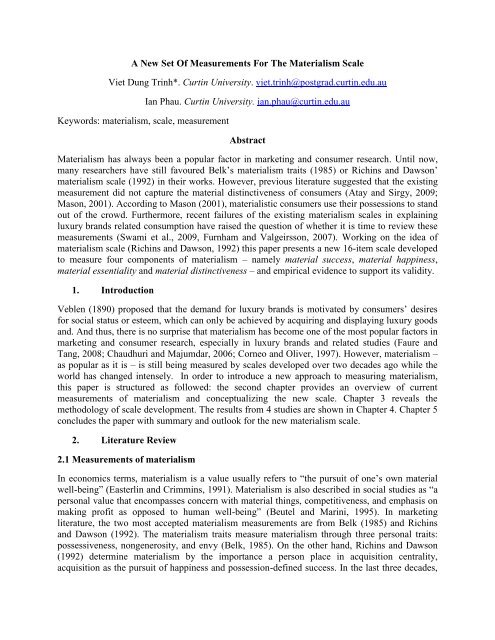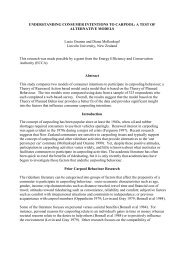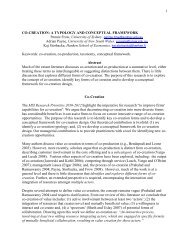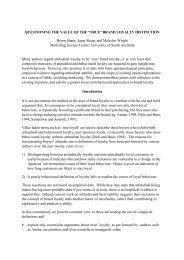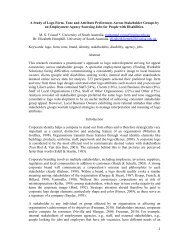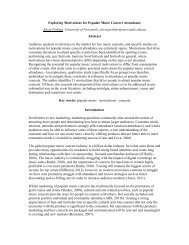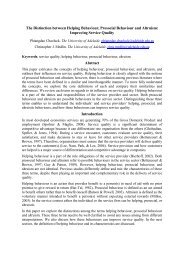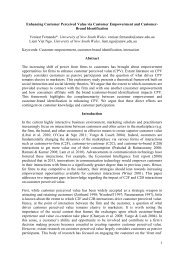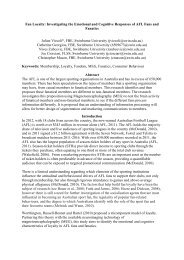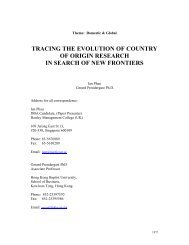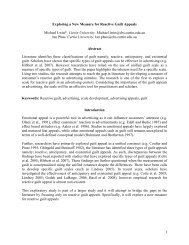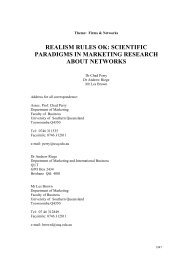A New Set Of Measurements For The Materialism Scale ... - ANZMAC
A New Set Of Measurements For The Materialism Scale ... - ANZMAC
A New Set Of Measurements For The Materialism Scale ... - ANZMAC
You also want an ePaper? Increase the reach of your titles
YUMPU automatically turns print PDFs into web optimized ePapers that Google loves.
A <strong>New</strong> <strong>Set</strong> <strong>Of</strong> <strong>Measurements</strong> <strong>For</strong> <strong>The</strong> <strong>Materialism</strong> <strong>Scale</strong><br />
Viet Dung Trinh*. Curtin University. viet.trinh@postgrad.curtin.edu.au<br />
Keywords: materialism, scale, measurement<br />
Ian Phau. Curtin University. ian.phau@curtin.edu.au<br />
Abstract<br />
<strong>Materialism</strong> has always been a popular factor in marketing and consumer research. Until now,<br />
many researchers have still favoured Belk‟s materialism traits (1985) or Richins and Dawson‟<br />
materialism scale (1992) in their works. However, previous literature suggested that the existing<br />
measurement did not capture the material distinctiveness of consumers (Atay and Sirgy, 2009;<br />
Mason, 2001). According to Mason (2001), materialistic consumers use their possessions to stand<br />
out of the crowd. Furthermore, recent failures of the existing materialism scales in explaining<br />
luxury brands related consumption have raised the question of whether it is time to review these<br />
measurements (Swami et al., 2009, Furnham and Valgeirsson, 2007). Working on the idea of<br />
materialism scale (Richins and Dawson, 1992) this paper presents a new 16-item scale developed<br />
to measure four components of materialism – namely material success, material happiness,<br />
material essentiality and material distinctiveness – and empirical evidence to support its validity.<br />
1. Introduction<br />
Veblen (1890) proposed that the demand for luxury brands is motivated by consumers‟ desires<br />
for social status or esteem, which can only be achieved by acquiring and displaying luxury goods<br />
and. And thus, there is no surprise that materialism has become one of the most popular factors in<br />
marketing and consumer research, especially in luxury brands and related studies (Faure and<br />
Tang, 2008; Chaudhuri and Majumdar, 2006; Corneo and Oliver, 1997). However, materialism –<br />
as popular as it is – is still being measured by scales developed over two decades ago while the<br />
world has changed intensely. In order to introduce a new approach to measuring materialism,<br />
this paper is structured as followed: the second chapter provides an overview of current<br />
measurements of materialism and conceptualizing the new scale. Chapter 3 reveals the<br />
methodology of scale development. <strong>The</strong> results from 4 studies are shown in Chapter 4. Chapter 5<br />
concludes the paper with summary and outlook for the new materialism scale.<br />
2. Literature Review<br />
2.1 <strong>Measurements</strong> of materialism<br />
In economics terms, materialism is a value usually refers to “the pursuit of one‟s own material<br />
well-being” (Easterlin and Crimmins, 1991). <strong>Materialism</strong> is also described in social studies as “a<br />
personal value that encompasses concern with material things, competitiveness, and emphasis on<br />
making profit as opposed to human well-being” (Beutel and Marini, 1995). In marketing<br />
literature, the two most accepted materialism measurements are from Belk (1985) and Richins<br />
and Dawson (1992). <strong>The</strong> materialism traits measure materialism through three personal traits:<br />
possessiveness, nongenerosity, and envy (Belk, 1985). On the other hand, Richins and Dawson<br />
(1992) determine materialism by the importance a person place in acquisition centrality,<br />
acquisition as the pursuit of happiness and possession-defined success. In the last three decades,
these two measurements have been employed in so many research for finding indication of<br />
materialism in consumer behavior from luxury brands (Zhao and Belk, 2002; Belk and Zhou,<br />
2001; Corneo and Oliver, 1997; Richins and Dawson, 1992; Easterlin and Crimmins, 1991; Belk<br />
1985) to counterfeit luxury brands (Lu and Lu, 2010; Wan et al., 2009; Swami et al., 2009;<br />
Furnham and Valgeirsson, 2007; Wee et al., 1995). But the two scales have not always been<br />
successful in explaining consumer behavior, especially in recent years (Swami et al., 2009;<br />
Furnham and Valgeirsson, 2007). In a research investigating the non-price determinants of<br />
intention to purchase counterfeit goods in Singapore, Belk‟s scale to measure materialism traits<br />
was adapted but failed the reliability test (Wee et al., 1995). <strong>The</strong> results from recent attempts<br />
using Richin‟s materialism scale to study materialism in the consumption of counterfeit luxury<br />
brands have also showed the inconsistency (Lu and Lu, 2010; Wan et al., 2009; Swami et al.,<br />
2009) and divergence between the 3 components of the scale (Wan et al., 2009; Furnham and<br />
Valgeirsson, 2007).<br />
Belk introduced the materialism traits in the „80s while Richins and Dawson 18 item-scale was<br />
formed in early „90s. Since then, the world has changed significantly. Emerging markets such as<br />
China and those from old Soviet blocs have risen to power. China for example, is now one the<br />
largest market for luxury goods (<strong>The</strong> Economist, 2011). But what Chinese consumers are<br />
demanding is very different with consumers from the West because of various reasons, such as<br />
cultural factors and/or new wealth (KPMG, 2008). <strong>The</strong>refore, a new materialism scale is required<br />
to deliver better measurement of materialism of consumers.<br />
2.2 <strong>Scale</strong> conceptualization<br />
<strong>The</strong> materialism scale (Richins and Dawson, 1992) provides a good framework for a new scale<br />
because it was built based on the idea that materialism is a value that guides the conduct of one‟s<br />
life. In a certain way, it has already included Belk‟s materialism traits in its three themes:<br />
material success, material centrality and material happiness.<br />
“Material Success measures the extent to which one uses possessions as indicators of<br />
success and achievement in life, both in judging oneself and others.<br />
Material Centrality measures the extent to which possessions are placed in the center of<br />
one‟s life.<br />
Material Happiness measures the extent to which one believes that possessions are<br />
critical to satisfaction and well-being in life.” (Richins and Dawson, 1992)<br />
Though it provided a good foundation to materialism, the 18-item scale of Richins and Dawson<br />
has concentrated on the relationship between one and his possession; and thus lacked the ability<br />
to measure status latent for each dimension. Among the 18 items, there are only 2 items dedicated<br />
to study the status latent– Q3 I don’t place much emphasis on the amount of material objects<br />
people own as a sign of success, and Q4 <strong>The</strong> things I own say a lot about how well I’m doing in<br />
life.<br />
Furthermore, materialistic people are said to pursue social recognition and status and using their<br />
possessions to distinguish themselves from others (Mason, 2001). <strong>Materialism</strong> is also often<br />
associated with conspicuous consumption, in which consumer satisfaction is derived from<br />
audience reaction rather than functionality of the item. In other words, materialistic people are
seen to focus on the consumption of “status goods” and unique consumer products to distinguish<br />
themselves (Lynn and Harris, 1997), hence the introduction of distinctiveness into the scale.<br />
3. Methodology<br />
3.1 <strong>Scale</strong> Design<br />
<strong>The</strong> development of the scale closely followed recommended psychometric scaling procedures<br />
(DeVellis, 2003). First a convenience sample of 20 consumers –age between 25 and 50 with<br />
higher educational background in business related studies– was asked to describe the<br />
characteristics of materialistic people related to luxury brands usage behavior. Items were then<br />
generated from these responses. In addition, items were also generated from previously<br />
developed materialism scales and the materialism literature (Atay and Sirgy, 2009; Richins and<br />
Dawson, 1992; Richins, 1987; Belk, 1985). A pool of 70 items was generated. <strong>The</strong>se items were<br />
then screened for ambiguity and reviewed by a panel of experts – luxury brands marketing<br />
professionals and academia. This pool was later trimmed to 47 items, including 18 items from<br />
Richins and Dawson (1992), via exploratory factor analysis and reliability analysis. Through a<br />
number of other scaling procedures (factor analysis, reliability analysis and validity check) across<br />
several samples, a final scale consisting 16 items was retained – with none from the original<br />
scale. <strong>The</strong> final scale was then administered to consumers in Vietnam via a market research<br />
survey conducted by Taylor Nelson Sofres (TNS) – a market research agency.<br />
3.2 <strong>The</strong> Sample<br />
A convenience sample of 20 consumers –age between 25 and 50 with higher educational<br />
background in business related studies– was used for item generation. Three samples of students<br />
(n=184, 89 and 419) were used to examine the reliability and validity of the scales. All<br />
participants are undergraduate business students from a large university in Australia and they<br />
participated in the study as part of a course requirement. <strong>Of</strong> this group, 60 percent of the<br />
respondents were female and almost 90 percent were under 25 years old. <strong>The</strong> use of student<br />
sample is usually deemed as a potential limitation due to its homogeneity; however Richins and<br />
Dawson (1992) also used student samples in developing the original scale. And more importantly<br />
the results later showed scale components were found to be unwavering regardless to changes in<br />
demographic characteristics of a sample.<br />
<strong>The</strong> final test was conducted with a consumer sample of n=400, from two biggest cities of<br />
Vietnam (Hanoi and Ho Chi Minh City). <strong>The</strong> gender ratio was 50-50, 34 percent of the<br />
respondent were under 25; the largest group (53 percent) was from 26 to 45 years old.<br />
3.3 Data Collection Method<br />
Online survey platform was used to aid data collection from the 3 student samples. English<br />
version of the questionnaire was used to collect data from student samples. <strong>For</strong> the consumer<br />
sample, TNS was contracted to collect the data. <strong>The</strong> questionnaire was prepared in Vietnamese<br />
with clear instructions in each section for interviewers. Data collection method was door-to-door<br />
interview. Household were chosen randomly from a data pool across the city. Respondents were<br />
also selected randomly within the household. If the chosen respondent was not at home,<br />
interviewers would come back later. Twenty percent of the completed questionnaire were<br />
subjected for quality controlled (QC). Respondents were revisited by QC team to go through a<br />
shorter survey consisting key questions to make sure the reliability of the whole study.
4. Results<br />
<strong>The</strong> 16 items of <strong>Materialism</strong> <strong>Scale</strong> were subjected to exploratory factor analysis (EFA) using<br />
SPSS version 19. Prior to performing the EFA, the suitability of data for factor analysis was<br />
assessed. In all samples, inspection of the correlation matrix revealed the presence of many<br />
coefficients of .3 and above. <strong>The</strong> Kaiser Meyer-Olkin values for the three student samples were<br />
.775, .817 and .860 while KMO values for the consumer sample from Vietnam was .895, all<br />
exceeding the recommended value of .6 (Kaiser, 1970; 1974) and Bartlett‟s Test of Sphericity<br />
(Bartlett, 1954) reached statistical significance supporting the factorability of the correlation<br />
matrix.<br />
EFA and reliability analysis revealed the presence of four factors with eigenvalues exceeding 1.<br />
An inspection of the scree plot also supported the four-factor solution by showing a clear break<br />
after the fourth component (Catell, 1996). To aid in the interpretation of these four factors,<br />
Varimax rotation was performed. <strong>The</strong> rotated component matrix for the 3 student samples is<br />
shown in Table 1. Based on the result, four factors are namely Material Success, Material<br />
Happiness, Material Essentiality and Material Distinctiveness. Through four different occasions<br />
of the study, the original set of questions for Material Centrality was found to measure various<br />
factors and therefore it has to be replaced by Material Essentiality, which provides a more<br />
concrete appraisal of the belief that possessions are essential and responsible for everything in<br />
one‟s life. This belief is also found to be more in line with the whole idea of materialism and<br />
much clearer than the vague “the extent to which possessions are placed in the center of one‟s<br />
life” of the Material Centrality. And Material Distinctiveness measures the extent to which one<br />
uses possessions as a device to stand out of the crowd.<br />
Table 1: Rotate Component Matrix<br />
Student<br />
Student<br />
Student<br />
Consumer<br />
Items<br />
Sample 1 (n=184) Sample 2 (n=89) Sample 3 (n=419) Sample (n=400)<br />
1 2 3 4 1 2 3 4 1 2 3 4 1 2 3 4<br />
Material Success. a .736 .833 .788<br />
.817<br />
Material Success. b .833 .880 .840 .845<br />
Material Success. c .840 .340 .766 .800 .826<br />
Material Success. d .757 .307 .865 .816 .817<br />
Material Happiness. a .696 .669 .705<br />
.753<br />
Material Happiness. b .711 .796 .740 .730<br />
Material Happiness. c .791 .845 .830 .820<br />
Material Happiness. d .775 .750 .779 .772<br />
Material Essentiality. a .942 .734 .475 .855 .820<br />
Material Essentiality. b .916 .914 .898 .878<br />
Material Essentiality. c .944 .902 .878 .866<br />
Material Essentiality. d .911 .844 .856 .831<br />
Material Distinctiveness. a .838 .874 .847<br />
.858<br />
Material Distinctiveness. b .857 .894 .854 .859<br />
Material Distinctiveness. c .421 .856 .706 .831<br />
Material Distinctiveness. d .742 .671 .720 .753<br />
Over the 3 student samples, coefficient alpha estimates for the factors ranged from .863 to .906<br />
for the success factor, from .813 to .859 for the happiness factor, from .824 to .969 for the<br />
essentiality, and .732 to .900 for the distinctiveness factor. Alpha for the overall 16-item scale
anged between .849 and .910. <strong>The</strong> final consumer sample produced coefficient alpha estimates<br />
.929 for the success factor, .858 for the happiness factor, .936 for the essentiality, and .893 for the<br />
distinctiveness factor. In short, the Cronbach‟s alpha value are all well above the recommend<br />
criterion of 0.7 (Pallant, 2000), providing strong evidence for internal consistency of the scales.<br />
5. Conclusion<br />
Richins and Dawson‟ materialism scale (1992) has provided a good measurement of materialism<br />
in marketing and consumer research, especially those involved in luxury brands and related, for<br />
over two decades. But the world market has changed significantly since then, and now it requires<br />
a different measurement to capture materialism. After reliability and validity assessments, the<br />
new 16-item materialism scale has been proved to be in good standard and will provide reliable<br />
results.<br />
<strong>The</strong> set of measurements developed in this study would contribute to the growing understanding<br />
of why consumers buy luxury brands as well as counterfeit luxury brands. As pointed out by<br />
earlier literature, other materialism scales were not able to grasp the importance of possession in<br />
the path to become more distinctive. Material Distinctiveness provides a set of measurement to<br />
take a hold of this idea. This is very important and will become handy in cross cultural<br />
assessment. <strong>For</strong> example, consumers with lower material distinctiveness would prefer to<br />
purchase a more conspicuous version of the brand as the needs for displaying the logo of luxury<br />
brands is so great whereas consumers with higher material distinctiveness would go after a more<br />
discreet version of a luxury brand to stand out of the crowd. All the questions for other<br />
components such as Material Success, Material Happiness and Material Essentiality were also<br />
reviewed and replaced with a better measurement for benefits of owning a possession, and<br />
evaluating the status latent.<br />
Finally, the new materialism scale does not only answer the gap of contribute the marketing<br />
literature but also add valuable insights for luxury brands management. Further research<br />
employing the new set of measurements will provide luxury brands with better understanding of<br />
what drive consumers toward their brands so they can come up with more effective strategies and<br />
designs. In addition, the scale would also benefit many other marketing professionals who are in<br />
need of a tool to study consumer behaviour. As the new materialism scale measure the status<br />
latent and benefits of owning a possession, it can also be used as a tool to study any service<br />
related products. <strong>For</strong> example, a company that sells luxury cruise trips in tourism industry, a<br />
marketing executive for a private high school or even an anti-counterfeit agency fighting against<br />
fake luxury brands would find this scale useful and benefit from it. This research also suggest<br />
that the new set of measurement have a high generalizability as it was administered and got<br />
positive results in various locations (Australia, Vietnam), cross-culture (North and South<br />
Vietnam; Vietnamese and Australian). Future research and longitudinal study using the new scale<br />
to measure materialism of consumers is recommended.<br />
6. References<br />
Atay E.G., Sirgy J., 2009, Developing a new measure of materialism, Advances in Consumer<br />
Research Asia Pacific Conference Proceeding, 35, p.907<br />
Bartlett M.S., 1954. A note on the multiplying factors for various chi square approximations.<br />
Journal of the Royal Statistical Society, 16, pp. 296-298.
Belk R., Zhou N., 2001. A reader response analysis of global and local appeals Chinese<br />
advertising, Salt Lake City Utah: Odyssey Films (21 minutes video)<br />
Belk, R.W., 1985. <strong>Materialism</strong>: trait aspects of living in a material world. Journal of<br />
Consumer Research 12, pp. 265 – 280.<br />
Beutel, A.M., Marini, M.M., 1995. Genders and values. American Sociological Review 60,<br />
pp. 436 – 448.<br />
Catell R.B., 1966. <strong>The</strong> scree test for number of factors. Multivariate Behavioural Research, 1,<br />
245-276.<br />
Chaudhuri H.R., Majumdar S., 2006. <strong>Of</strong> Diamonds and Desires: Understanding Conspicuous<br />
Consumption from Contemporary Marketing Perspective, Academy of Marketing Review,<br />
2006 (11), 2-18.<br />
Corneo G., Olivier J., 1997. Conspicuous Consumption, Snobbism and Conformism, Journal<br />
of Public Economics, 66(Oct), pp. 55-71.<br />
DeVellis, R.F., 2003. <strong>Scale</strong> Development: <strong>The</strong>ory and Application, 2 nd . <strong>New</strong>bury Park, Sage<br />
Easterlin, R.A. and Crimmins, E.M., 1991. Private materialism, personal self-fulfilment,<br />
family life and public interest: the nature, effects, and causes of recent changes in the values<br />
of American youth. Public Opinion Quarterly 55, pp. 499 – 533.<br />
Eastman, J.K, Goldsmith, R.E, Flynn, L.R., 1999. Status Consumption in Consumer<br />
Behavior: <strong>Scale</strong> Development and Validation. Journal of Marketing <strong>The</strong>ory and Practice 7<br />
(3), 41-52.<br />
Faure G. O., Fang T., 2008. Changing Chinese values: Keeping up with paradoxes,<br />
International Business Review, 17, 194-207.<br />
Furnham, A., Valgeirsson, H. 2007. <strong>The</strong> effect of life values and materialism on buying<br />
counterfeit products. Journal of Socio-Economics 36 (5), 677-685.<br />
Kaiser H., 1970. A second generation Little Jiffy. Psychometrika, 35, 401-415.<br />
Kaiser H., 1974. An index of factorial simplicity. Psychometrika, 39, 31-36.<br />
KPMG, 2008, China‟s Luxury Consumers: Moving up the Curve, available at<br />
http://www.kpmg.com.hk/<br />
Lu L.C., Lu C.J., 2010 Moral Philosophy, <strong>Materialism</strong> and Consumer Ethics: An Exploratory<br />
Study in Indonesia, Journal of Business Ethics, 94, 193-210.<br />
Lynn, M. and Harris, J., 1997. <strong>The</strong> desire for unique consumer products: a new individual<br />
differences scale. Psychological Marketing 14, pp. 601 – 616.<br />
Mason, R. S., 2001. Conspicuous consumption: A literature review. European Journal of<br />
Marketing 18 (3), 26 - 39.<br />
Pallant J., 2000. Development and validation of a scale to measure perceived control of<br />
internal states. Journal of Personality Assessment, 75, 2, 308-337.<br />
Richins, M.L., 1987. Media, <strong>Materialism</strong>, and Human Happiness. Advances in Consumer<br />
Research Vol. 14, 352-356.<br />
Richins, M.L., Dawson, S., 1992. A consumer values orientation for materialism and its<br />
measurement: scale development and validation. Journal of Consumer Research 19, pp. 303<br />
– 316.<br />
Swami V., Chamorro-Premuzic T., Furnham A., 2009. Faking it: Personality and individual<br />
difference predictors of willingness to buy counterfeit goods, <strong>The</strong> Journal of Socio-<br />
Economics, 38, 820-825.<br />
<strong>The</strong> Economist, 2011, <strong>The</strong> Middle Blingdom, published on 17 Feb 2011, available at<br />
http://www.economist.com/node/18184466
Tom, G., Garibaldi, B., Zeng, Y., Pilcher, J., 1998. Consumer demand for counterfeit brands.<br />
Psychology and Marketing 15, 405–421.<br />
Veblen, T., 1899, <strong>The</strong> theory of the leisure class, Dover Publications, <strong>New</strong> York.<br />
Wan W.W.N., Luk C.L., Yau O.H.M., Tse A.C.B., Sin L.Y.M., Kwong K.K., Chow R.P.M.<br />
2009. Do traditional Chinese Cultural Values Nourish a Market for Pirated CDs?, Journal of<br />
Business Ethics, 88, 185-196.<br />
Ward, S., Wackman, D., 1971. Family and media influences on adolescent consumer<br />
learning. American Behavioural Scientist 14, pp. 415 – 427.<br />
Wee, C., Tan, S.-J., Cheok, K.-H., 1995. Non-price determinants of intention to purchase<br />
counterfeit brands. International Marketing Review 12, 19–47.<br />
Zhao X., Belk R., 2006. Sinolization: An International Advertising Strategy for China,<br />
Journal of Asia Pacific Marketing 1 (1), 3-18.<br />
7. Appendix<br />
Final <strong>Scale</strong> Items<br />
Material Success Measures (1=“Strongly Disagree,” and 7=”Strongly Agree”)<br />
a. I like to own things that make people think highly of me<br />
b. I like to own expensive things than most people because this is a sign of success<br />
c. <strong>The</strong> only way to let everyone know about my high status is to show it<br />
d. I feel good when I buy expensive things. People think of me as a success<br />
Material Happiness Measures (1=“Strongly Disagree,” and 7=”Strongly Agree”)<br />
a. Material possessions are important because they contribute a lot to my happiness<br />
b. When friends have things I cannot afford, it bothers me<br />
c. Acquiring valuable things is important for my happiness<br />
d. To me, it is important to have expensive homes, cars, clothes, and other things. Having<br />
these expensive items make me happy<br />
Material Essentiality Measures (1=“Strongly Disagree,” and 7=”Strongly Agree”)<br />
a. Material growth has an irresistible attraction for me<br />
b. Material accumulation helps raise the level of civilization<br />
c. Growth in material consumption helps raise the level of civilization<br />
d. To buy and possess expensive things is very important to me<br />
Material Distinctiveness Measures (1=“Strongly Disagree,” and 7=”Strongly Agree”)<br />
a. I usually buy things that make me look distinctive<br />
b. I like to own things that make people think of me as unique and different<br />
c. I feel uncomfortable when seeing a random person wears the same clothes that I am<br />
wearing<br />
d. I would rather pay more to get a more distinctive item


